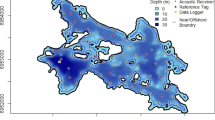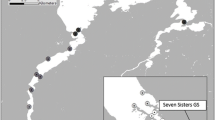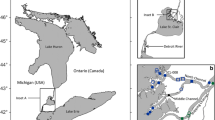Abstract
A telemetry study was conducted on lake sturgeon to determine the seasonal use and environmental factors that stimulate movement within a tributary of a larger system. Over a 10-year period, 52 lake sturgeon implanted with acoustic transmitters were monitored through an array of Vemco receivers with the Blanche River, Ontario. An average of 68% of the tagged fish entered the tributary annually whereas only 19.2% of those were detected on known spawning areas approximately 54 km upstream. Water temperature, lunar phase, lake water level, presumed spawning fish, and water discharge were all considered significant variables associated with the onset of upstream migration. Water temperature (mean 12.9 °C) was the only variable that explained the timing and the arrival at the spawning grounds. Sturgeon remained at the spawning area for a mean duration 7.9 days; however, none of the variables examined explained the duration of stay. Water temperature was the only variable that explained departure from the spawning areas (mean 15.8 °C). Mean time spent in the river after spawning was 30.5 days. There was not a significant difference in sex or total length in relationship to the duration tagged fish stayed in the river after spawning. The entire Blanche River up to the insuperable rapids was used by the sturgeon with the exception of minor tributaries. Water temperature, river discharge, and fish size were all considered significant factors initiating out-migration back into the lake. This study demonstrated the importance and seasonal use of a tributary by lake sturgeon. Correlations from abiotic variable and seasonal response could be used to establish guidelines for water management purposes when the goal is to conserve or restore sturgeon populations within a river system. This study also illustrates the importance of tributaries in association to a larger waterbody for lake sturgeon.








Similar content being viewed by others
Data availability
Data is available from the authors upon reasonable request.
Code availability
Code for GLMs is available from the authors upon reasonable request.
References
Auer NA (1996) Response of spawning lake sturgeons to change in hydroelectric facility operation. Trans Am Fish Soc 125:66–77. https://doi.org/10.1577/1548-8659(1996)125%3c0066:ROSLST%3e2.3.CO;2
Auer NA (1999) Population characteristics and movement of lake sturgeon in the Sturgeon River and Lake Superior. J Great Lakes Res 25:282–293
Bemis WE, Kynard B (1997) Sturgeon rivers: an introduction to acipenseriform biogeography and life. Environ Ecol Stat 48:167–183
Bemis WE, Findeis EK, Grande L (1997) An overview of Acipenseriformes. Environ Biol Fish 48:25–71
Boothroyd MLE, Haxton TJ, Hendry C et al (2019) Post-release dispersal and spawning movements of a translocated lake sturgeon (Acipenserfulvescens, Rafinesque 1817) population in the Mattagami River, Ontario. J Appl Ichthyol 35:103–116. https://doi.org/10.1111/jai.13872
Borkholder BDBD, Morse SDSD, Weaver HTHT et al (2002) Evidence of a year-round resident population of lake sturgeon in the Kettle River, Minnesota, based on radiotelemetry and tagging. North Am J Fish Manag 22:888–894. https://doi.org/10.1577/1548-8675(2002)022%3c0888:EOAYRR%3e2.0.CO;2
Bruch RM, Binkowski FP (2002) Spawning behavior of lake sturgeon (Acipenserfulvescens). J Appl Ichthyol 18:570–579. https://doi.org/10.1046/j.1439-0426.2002.00421.x
Colborne SF, Hondorp DW, Holbrook CM et al (2019) Sequence analysis and acoustic tracking of individual lake sturgeon identify multiple patterns of river–lake habitat use. Ecosphere 10:e02983. https://doi.org/10.1002/ecs2.2983
Colborne SF, Hayden TA, Holbrook CM et al (2021) Lake sturgeon (Acipenserfulvescens) annual adult survival estimated from acoustic telemetry. J Great Lakes Res 47:1814–1823. https://doi.org/10.1016/j.jglr.2021.08.007
Cooke SJ, Paukert C, Hogan Z (2012) Endangered river fish: factors hindering conservation and restoration. Endanger Species Res 17:179–191. https://doi.org/10.3354/esr00426
Dammerman KJ, Webb MAH, Scribner KT (2019) Riverine characteristics and adult demography influence female lake sturgeon (Acipenserfulvescens) spawning behavior, reproductive success, and ovarian quality. Can J Fish Aquat Sci 76:1147–1160. https://doi.org/10.1139/cjfas-2018-0141
Dynesius M, Nilsson C (1994) Fragmentation and flow regulation of riversystems in the northern third of the world. Science 266:753–762
Ecclestone A, Haxton TJ, Pratt TC et al (2020) Seasonal use of two unregulated Lake Superior tributaries by lake sturgeon. J Great Lakes Res 46:1369–1381. https://doi.org/10.1016/j.jglr.2020.06.008
Forsythe PS, Crossman JA, Bello NM et al (2012a) Individual-based analyses reveal high repeatability in timing and location of reproduction in lake sturgeon (Acipenserfulvescens). Can J Fish Aquat Sci 72:60–72. https://doi.org/10.1139/F2011-132
Forsythe PS, Scribner KT, Crossman JA et al (2012b) Environmental and lunar cues are predictive of the timing of river entry and spawning-site arrival in lake sturgeon Acipenserfulvescens. J Fish Biol 81:35–53. https://doi.org/10.1111/j.1095-8649.2012.03308.x
Fortin R, Guenette S, Dumont P (1992) Biologie, exploitation, modélisation et gestion des populations d’Esturgeon jaune (Acipenser fulvescens) dans 14 réseaux de lacs et de rivières du Québec. Ministere du Loisir, de la Chasses et de la Peche, Montreal, QC. 148 pp. + Annexe
Gao X, Li MZ, Lin PC et al (2013) Environmental cues for natural reproduction of the Chinese sturgeon, Acipensersinensis Gray, 1835, in the Yangtze River, China. J Appl Ichthyol 29:1389–1394. https://doi.org/10.1111/jai.12363
Goto D, Hamel MJ, Hammen JJ et al (2014) Spatiotemporal variation in flow-dependent recruitment of long-lived riverine fish: model development and evaluation. Ecol Modell 296:79–92
Grill G, Lehner B, Lumsdon AE et al (2015) An index-based framework for assessing patterns and trends in river fragmentation and flow regulation by global dams at multiple scales. Environ Res Lett 10:015001. https://doi.org/10.1088/1748-9326/10/1/015001
Harkness WJK, Dymond JR (1961) The Lake Sturgeon: the history of its fishery and problems of conservation. Ontario, Toronto
Haxton TJ (2008) A synoptic review of the history and our knowledge of lake sturgeon in the Ottawa River. Ontario Ministry of Natural Resources, Southern Science & Information Section, Peterborough, Ontario, pp 31
Haxton TJ (2011) Depth selectivity and spatial distribution of juvenile lake sturgeon in a large, fragmented river. J Appl Ichthyol 27:45–52. https://doi.org/10.1111/j.1439-0426.2011.01872.x
Haxton TJ, Findlay CS (2009) Variation in large-bodied fish-community structure and abundance in relation to water-management regime in a large regulated river. J Fish Biol 74:2216–2238. https://doi.org/10.1111/j.1095-8649.2009.02226.x
Haxton TJ, Friday M, Cano T, Hendry C (2014) Variation in lake sturgeon (Acipenserfulvescens Rafinesque, 1817) abundance in rivers across Ontario, Canada. J Appl Ichthyol 30:1335–1341. https://doi.org/10.1111/jai.12550
Hilton EJ, Grande L (2006) Review of the fossil record of sturgeons, family Acipenseridae (Actinopterygii: Acipenseriformes), from North America. J Paleontol 80:672–683. https://doi.org/10.1666/0022-3360(2006)80[672:ROTFRO]2.0.CO;2
Houston JJ (1987) Status of the Lake Sturgeon, Acipenserfulvescens, in Canada. Can Field-Naturalist 101:171–185
Ingram EC, Peterson DL (2018) Seasonal movements of shortnose sturgeon (Acipenserbrevirostrum) in the Altamaha River, Georgia. River Res Appl 34:873–882. https://doi.org/10.1002/rra.3322
Jones NE (2010) Incorporating lakes within the river discontinuum: longitudinal changes in ecological characteristics in stream–lake networks. Can J Fish Aquat Sci 67:1350–1362. https://doi.org/10.1139/F10-069
Kelso JRM, Steedman RJ, Stoddart S (1996) Historical causes of change in Great Lakes fish stocks and the implications for ecosystem rehabilitation. Can J Fish Aquat Sci 53:10–19. https://doi.org/10.1139/cjfas-53-S1-10
Kempinger JJ (1988) Spawning and early life history of lake sturgeon in the Lake Winnebago system, Wisconsin. Am Fish Soc Symp 5:110–122
Kéry M, Schaub M (2012) Bayesian population analysis using WinBUGS - a hierarchical perspective. Academic Press, Oxford, England
Kessel ST, Hondorp DW, Holbrook CM et al (2018) Divergent migration within lake sturgeon (Acipenserfulvescens) populations: multiple distinct patterns exist across an unrestricted migration corridor. J Anim Ecol 87:259–273. https://doi.org/10.1111/1365-2656.12772
Knights BC, Vallazza JM, Zigler SJ, Dewey MR (2002) Habitat and movement of Lake Sturgeon in the Upper Mississippi River System, USA. Trans Am Fish Soc 131:507–522
Lallaman JJJ, Damstra RAA, Galarowicz TLL (2008) Population assessment and movement patterns of lake sturgeon (Acipenserfulvescens) in the Manistee River, Michigan, USA. J Appl Ichthyol 24:1–6. https://doi.org/10.1111/j.1439-0426.2007.01032.x
McCabe MM, Chiotti JA, Boase JC et al (2019) Assessing acoustic tagging effects on survival, growth, and swimming ability of juvenile lake sturgeon. North Am J Fish Manag 39:574–581. https://doi.org/10.1002/nafm.10294
Papoulias DM, Delonay AJ, Annis ML et al (2011) Characterization of environmental cues for initiation of reproductive cycling and spawning in shovelnose sturgeon Scaphirhynchusplatorynchus in the Lower Missouri River, USA. J Appl Ichthyol 27:335–342. https://doi.org/10.1111/j.1439-0426.2010.01657.x
Paradis Y, Bernatchez S, Valiquette É et al (2022) A review of lake sturgeon Acipenserfulvescens spawning sites in the Lower St. Lawrence and Ottawa river systems. J Great Lakes Res 48:857–864. https://doi.org/10.1016/j.jglr.2022.05.011
Paragamian VL, Wakkinen VD (2002) Temporal distribution of Kootenai River white sturgeon spawning events and the effect of flow and temperature. J Appl Ichthyol 18:542–549. https://doi.org/10.1046/j.1439-0426.2002.00391.x
Paragamian VL, Wakkinen VD (2011) White sturgeon spawning and discharge augmentation. Fish Manag Ecol 18:314–321. https://doi.org/10.1111/j.1365-2400.2011.00785.x
Paragamian VL, Wakkinen VD, Kruse G (2002) Spawning locations and movement of Kootenai River white sturgeon. J Appl Ichthyol 18:608–616. https://doi.org/10.1046/j.1439-0426.2002.00397.x
Peterson DL, Vecsei P, Jennings CA (2007) Ecology and biology of the lake sturgeon: a synthesis of current knowledge of a threatened North American Acipenseridae. Rev Fish Biol Fish 17:59–76. https://doi.org/10.1007/s11160-006-9018-6
Pikitch EK, Doukakis P, Lauck L et al (2005) Status, trends and management of sturgeon and paddlefish fisheries. Fish Fish 6:233–265. https://doi.org/10.1111/j.1467-2979.2005.00190.x
Plummer M, Best NG, Cowles K, Vines K (2006) CODA: output analysis and diagnostics for MCMC. R News 6:7–11
Poff NL, Allan JD, Bain MB et al (1997) The natural flow regime: a paradigm for river conservation and restoration. Bioscience 47:769–784
Poff NL, Olden JD, Merritt DM, Pepin DM (2007) Homogenization of regional river dynamics by dams and global biodiversity implications. Proc Natl Acad Sci U S A 104:5732–5737. https://doi.org/10.1073/pnas.0609812104
Pracheil BM, Pegg MA, Mestl GE (2009) Tributaries influence recruitment of fish in large rivers. Ecol Freshw Fish 18:603–609. https://doi.org/10.1111/j.1600-0633.2009.00376.x
Pracheil BM, McIntyre PB, Lyons JD (2013) Enhancing conservation of large-river biodiversity by accounting for tributaries. Front Ecol Environ 11:124–128. https://doi.org/10.1890/120179
Pratt TC, Gardner WM, Pearce J et al (2014) Identification of a robust Lake Sturgeon (Acipenserfulvescens Rafinesque, 1917) population in Goulais Bay, Lake Superior. J Appl Ichthyol 30:1328–1334. https://doi.org/10.1111/jai.12566
R Core Team (2014) R: a language and environment for statistical computing. R Foundation for Statistical Computing, Vienna. https://www.R-project.org/
Rosenberg DM, Berkes F, Bodaly RA et al (1997) Large-scale impacts of hydroelectric development. Environ Rev 5:27–54. https://doi.org/10.1139/a97-001
Rosenberg DM, McCully P, Pringle CM (2000) Global-scale environmental effects of hydrological alterations : introduction. Bioscience 50:746–751
Roussow G (1957) Some considerations concerning sturgeon spawning periodicity. J Fish Res Board Canada 14:553–572
Rusak JA, Mosindy T (1997) Seasonal movements of lake sturgeon in Lake of the Woods and the Rainy River, Ontario. Can J Zool 75:383–395. https://doi.org/10.1139/z97-048
Shaw SL, Chipps SR, Windels SK et al (2012) Lake sturgeon population attributes and reproductive structure in the Namakan Reservoir, Minnesota and Ontario. J Appl Ichthyol 28:168–175. https://doi.org/10.1111/j.1439-0426.2011.01927.x
Shaw SL, Chipps SR, Windels SK et al (2013) Influence of sex and reproductive status on seasonal movement of lake sturgeon in Namakan Reservoir, Minnesota - Ontario. Trans Am Fish Soc 142:10–20. https://doi.org/10.1080/00028487.2012.720625
Struthers DP, Gutowsky LFG, Enders EC et al (2017) Factors influencing the spatial ecology of Lake Sturgeon and Walleye within an impounded reach of the Winnipeg River. Environ Biol Fishes 100:1085–1103. https://doi.org/10.1007/s10641-017-0629-7
Thiem JD, Hatin D, Dumont P et al (2013) Biology of lake sturgeon (Acipenserfulvescens) spawning below a dam on the Richelieu River, Quebec: behaviour, egg deposition, and endocrinology. Can J Zool 91:175–186
Welsh AB, Baerwald MR, Friday M, May B (2015) The effect of multiple spawning events on cohort genetic diversity of lake sturgeon (Acipenserfulvescens) in the Kaministiquia River. Environ Biol Fishes 98:755–762. https://doi.org/10.1007/s10641-014-0309-9
Wozney KM, Haxton TJ, Kjartanson SL, Wilson CC (2011) Genetic assessment of lake sturgeon (Acipenserfulvescens) population structure in the Ottawa River. Environ Biol Fishes 90:183–195. https://doi.org/10.1007/s10641-010-9730-x
Acknowledgements
This study took place on lands that have been occupied by Indigenous Peoples for thousands of years and are located within the geographic boundary of Robinson-Huron Treaty territory. We would like to acknowledge the close relationship Indigenous Peoples have with the fishery resource from time immemorial and continues today.
We are especially grateful to the field staff that were integral to completing this project. Of particular note, the project would not have been possible if not for the field proficiencies and trouble-shooting skills provided by Derek Elliott, Michael Pratt, Tim Purdy, Shaun Walker, Craig Fuller, Leah Marinigh, Michel Rainville, Ashley Elliott, Christine Terwissen, Charlene Binkley, Don Crawford, Shamus Snell, Lisa McShane, and John McInnis of the Kirkland Lake District. We would also like to thank Charles Hendry and Bill Armstrong for their guidance and advice; Larry Ferguson and Emily Gryck for their roles in early project design; Mike Friday, Biodiversity and Monitoring Section for his review; the myriad other staff and students that assisted in the field; and the Kirkland Lake District, the Northeast Region, and the Aquatic Science and Monitoring Section of the Ministry of Natural Resources and Forestry for their support on this project.
Funding
Ontario Ministry of Northern Development, Mines, Natural Resources and Forestry.
Author information
Authors and Affiliations
Contributions
Both authors made substantial contributions to the conception and design of the work and the acquisition, analysis, or interpretation of data.
Corresponding author
Ethics declarations
Ethics approval
Work conducted on lake sturgeon in this study adhered to the guidelines of the Ontario Ministry of Northern Development, Mines, Natural Resources and Forestry Animal Care Council.
Consent to participate
N/A.
Conflict of interest
The authors declare no competing interests.
Additional information
Publisher's note
Springer Nature remains neutral with regard to jurisdictional claims in published maps and institutional affiliations.
Rights and permissions
About this article
Cite this article
McDonald, L., Haxton, T. Spatiotemporal use of a tributary by lake sturgeon over a 10-year period. Environ Biol Fish 106, 853–874 (2023). https://doi.org/10.1007/s10641-022-01384-9
Received:
Accepted:
Published:
Issue Date:
DOI: https://doi.org/10.1007/s10641-022-01384-9




